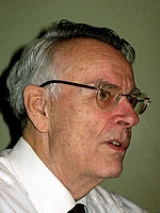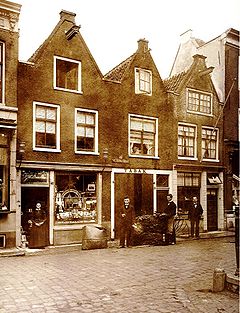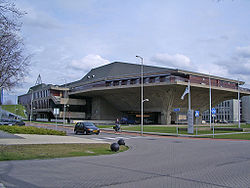
Frederik H. Kreuger
Encyclopedia


Amsterdam
Amsterdam is the largest city and the capital of the Netherlands. The current position of Amsterdam as capital city of the Kingdom of the Netherlands is governed by the constitution of August 24, 1815 and its successors. Amsterdam has a population of 783,364 within city limits, an urban population...
14 May 1928), is a Dutch high voltage
High voltage
The term high voltage characterizes electrical circuits in which the voltage used is the cause of particular safety concerns and insulation requirements...
scientist and inventor, lives in Delft
Delft
Delft is a city and municipality in the province of South Holland , the Netherlands. It is located between Rotterdam and The Hague....
, Holland, and is professor emeritus of the Delft University of Technology
Delft University of Technology
Delft University of Technology , also known as TU Delft, is the largest and oldest Dutch public technical university, located in Delft, Netherlands...
. He is also a professional author of technical literature, nonfiction books, thrillers and a decisive biography of the master forger Han van Meegeren
Han van Meegeren
Han van Meegeren , born Henricus Antonius van Meegeren, was a Dutch painter and portraitist, and is considered to be one of the most ingenious art forgers of the 20th century....
.
Biography
Frederik H. Kreuger stems from an old Amsterdam family where his maternal grandfather ran a small tobacco factory "Het Wapen van Spanje" in the Weteringstraat, in the old town near the Rijksmuseum. He published a Book about his grandfather, this tobacco factory and the explosive development of science and technique in the Belle ÉpoqueBelle Époque
The Belle Époque or La Belle Époque was a period in European social history that began during the late 19th century and lasted until World War I. Occurring during the era of the French Third Republic and the German Empire, it was a period characterised by optimism and new technological and medical...
, the period his grandfather lived.
He was educated in Haarlem
Haarlem
Haarlem is a municipality and a city in the Netherlands. It is the capital of the province of North Holland, the northern half of Holland, which at one time was the most powerful of the seven provinces of the Dutch Republic...
HBS B (a bèta-oriented secondary school), took his Engineer's degree
Engineer's degree
An engineer's degree is an advanced academic degree in engineering that is conferred in Europe, some countries of Latin America, and a few institutions in the United States....
at the Delft University of Technology
Delft University of Technology
Delft University of Technology , also known as TU Delft, is the largest and oldest Dutch public technical university, located in Delft, Netherlands...
in Holland and received there his Ph.D.
Doctor of Philosophy
Doctor of Philosophy, abbreviated as Ph.D., PhD, D.Phil., or DPhil , in English-speaking countries, is a postgraduate academic degree awarded by universities...
degree in 1961. He worked as a high voltage scientist in Sweden, England and Holland. In Holland he was employed by the electrical industry
Electrical power industry
The electric power industry provides the production and delivery of electric energy, often known as power, or electricity, in sufficient quantities to areas that need electricity through a grid connection. The grid distributes electrical energy to customers...
and became later managing director of the Nederlandse Kabelfabriek in Delft. In 1986 he became a high voltage professor of his Alma mater
Alma mater
Alma mater , pronounced ), was used in ancient Rome as a title for various mother goddesses, especially Ceres or Cybele, and in Christianity for the Virgin Mary.-General term:...
in Delft and worked there until 1995.
He is the inventor of several constructions for high voltage cable systems and of equipment for the detection of partial discharge
Partial discharge
In electrical engineering, partial discharge is a localised dielectric breakdown of a small portion of a solid or fluid electrical insulation system under high voltage stress, which does not bridge the space between two conductors...
s. Some examples are:
- balanced detection of partial discharges (P.D.s) (also called Kreuger bridge)
- discharge standard for partial discharge (P.D.) measurements.
- the (now usual) elastomerElastomerAn elastomer is a polymer with the property of viscoelasticity , generally having notably low Young's modulus and high yield strain compared with other materials. The term, which is derived from elastic polymer, is often used interchangeably with the term rubber, although the latter is preferred...
ic joints in solid H.V. cables (also called bi-manchet) - the (now usual) elastomerElastomerAn elastomer is a polymer with the property of viscoelasticity , generally having notably low Young's modulus and high yield strain compared with other materials. The term, which is derived from elastic polymer, is often used interchangeably with the term rubber, although the latter is preferred...
ic terminals for solid H.V. cables
His book Partial Discharge Detection was for twenty-five years the leading text book in this field. He has also published books about Management and Mismanagement in Research and Disadvantages of Wind Energy. His high voltage laboratory in Delft became a centre of knowledge for partial discharge detection and for the study of Direct current
Direct current
Direct current is the unidirectional flow of electric charge. Direct current is produced by such sources as batteries, thermocouples, solar cells, and commutator-type electric machines of the dynamo type. Direct current may flow in a conductor such as a wire, but can also flow through...
high voltage.
Kreuger is also the inventor of a system for gaining solar power from sea by large floating algea fields producing biofuel
Algae fuel
Algae fuel might be an alternative to fossil fuel and uses algae as its source of natural deposits. Several companies and government agencies are funding efforts to reduce capital and operating costs and make algae fuel production commercially viable...
(European Patent EP07110895 – 22 June 2007). This project is managed by the Botanical Garden of the Department Biotechnology of the Delft University of Technology; several departments of the University are cooperating herein.
Kreuger made a study of his fellow-townsman Johannes Vermeer
Johannes Vermeer
Johannes, Jan or Johan Vermeer was a Dutch painter who specialized in exquisite, domestic interior scenes of middle class life. Vermeer was a moderately successful provincial genre painter in his lifetime...
and Vermeer’s use of the Camera Obscura
Camera obscura
The camera obscura is an optical device that projects an image of its surroundings on a screen. It is used in drawing and for entertainment, and was one of the inventions that led to photography. The device consists of a box or room with a hole in one side...
. He also published a study about the location where Vermeer might have painted his Little Street (Vermeer)
The Little Street (Vermeer)
The Little Street is a painting by the Dutch painter Johannes Vermeer, executed c. 1657-1658. It is housed in the Rijksmuseum of Amsterdam, and signed left below the window with the writing "I V MEER".-See also:...
. An English translation of this study is present in the Municipal archives of Delft.
Kreuger started in 2001 to study the life of the famous Dutch forger Han van Meegeren
Han van Meegeren
Han van Meegeren , born Henricus Antonius van Meegeren, was a Dutch painter and portraitist, and is considered to be one of the most ingenious art forgers of the 20th century....
. His first book on Van Meegeren was a Dutch novel.
It was translated later on in English as "The Deception", also featuring some sketches about the life of Johannes Vermeer. A short biography "Real life of Van Meegeren" is found at the end of this novel.
Kreuger was in an opportune position to write his biography about Van Meegeren because his native language is Dutch and also because he lived in Holland at the time when Van Meegeren was active. He searched for primary sources – especially in Holland – and added in this way to the knowledge gained by John Godley, 3rd Baron Kilbracken
John Godley, 3rd Baron Kilbracken
John Raymond Godley, 3rd Baron Kilbracken, DSC was a British-born, later Irish-resident peer, wartime naval pilot, journalist, author and farmer. He was the son of the 2nd Baron Kilbracken; his grandfather, Arthur Godley, 1st Baron Kilbracken, was William Ewart Gladstone's private secretary...
, who was a pioneer in this field, and to that of Marie Louise Doudart de la Grée, who interviewed Van Meegeren in 1946 and wrote a Dutch biography
in 1966.
Kreuger was fortunate to meet the last living relatives of Han van Meegeren and also the last surviving witness of his arrest, and he discovered an unpublished biography of Van Meegeren’s son Jacques, containing new information on the artist’s life. Besides he found unknown photographs related to Van Meegeren.
In addition, he revealed paintings under the artist’s own name and he also identified some more fake Old Masters made by Van Meegeren.
In 2004 he published his findings in Dutch in "Han van Meegeren, Meestervervalser", where new facts and newly found works of Van Meegeren were collected.
In 2006 followed "De Arrestatie van een Meestervervalser", again in Dutch, in which the many reactions on his first biography were incorporated.
The resulting English biography A New Vermeer. Life and Work of Han van Meegeren 2007 was named after a notorious article A New Vermeer, where the great art-expert Dr. Abraham Bredius praised the Van Meegeren fake Emmaus as the finest Vermeer painting ever seen.
In this book he also describes the life of Van Meegeren's son Jacques van Meegeren
Jacques van Meegeren
Jacques van Meegeren , born Jacques Henri Emil van Meegeren, was a Dutch Illustrator and painter.He is also considered to be a forger of the work of his father Han van Meegeren...
; he discovered that Jacques in his turn had forged the work of his father.
Kreuger plays the leading violin in the amateur gipsy orchestra Siperkov Ensemble. He made a study of Gipsy or Romani music and published a book in Dutch about the history and perception of Gipsy music. An excerpt of this book appeared as the article "Zigeunermuziek" in the Dutch version of Wikipedia.
The following article reviews the career of Frederik Hendrik Kreuger and his work in the field of high voltage research:
Morshuis, P.H.F.: The scientific career of Frederik Hendrik Kreuger. Appears in:
IEEE Transactions on Dielectrics and Electrical Insulation Oct 1995, Volume 2, Issue 5, pages 711-716.
External links
- Kreuger’s two English books in Quantes
- Kreuger’s Van Meegeren Biography in Veen Magazines.
- Siperkov CD with Syncoop Produkties Records
- Website dedicated to Han van Meegeren
- YouTube: enter Siperkov in search-box
- User:Primasz/The Little Street of Vermeer and its Location Where painted Vermeer his Little Street?

